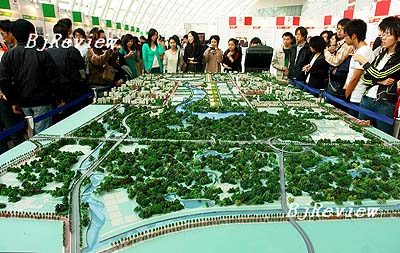|

Over the past five years, 44-year-old Na Heli has seen his home village, where his family has resided for five generations, replaced by Beijing Olympic Park. The park will be the heart of the Beijing 2008 Olympic Games. Covering a total area of 1,135 hectares, the park was designed to be a multi-functional community with business centers, exhibition halls, large-scale stadiums and entertainment facilities after the Games is finished.
"We lost our nests, but there is such an imposing Bird's Nest standing there," said a smiling Na, referring to the 100,000-seat National Olympic Stadium, a centerpiece venue for the 2008 Olympics in Beijing that will host the opening and closing ceremonies.
Na's village was chosen as the construction site for the Olympic Park in August 2002. While most villagers found it difficult to leave their homes, Na's 71-year-old father Na Zhong was the first villager to accept government relocation arrangements.
After moving to his new apartment in Beijing's northern suburbs, the father spent several hours traveling on buses back to his former village almost every day to see the construction of the Olympic competition venue progressing.
In March 2004, the father was one of the first selected torchbearers and the oldest for the Athens Olympics torch relay. He completed the 400-meter run, but soon afterward died of a heart attack, meaning he missed the second part of his Olympic ambition, to see the games in Beijing.
Na Heli is bidding to become an Olympic torchbearer for next year, in memory of his father's long-cherished Olympic dream. Even if he does not get the opportunity to eventually run with the Olympic torch, he has still made contributions to the Beijing Olympics in his daily work. Like most of his fellow villagers, he took a job offered by Beijing Xin'ao Group, the developer of the Olympic Park, after losing his farmland to the project. He is now a manager in the company's property management department.
Optimistic about the future use of the Olympic Park as a business and entertainment center after 2008, Na said, "The Olympics will only lift the curtain for a boom in this area."
Ancient city
Beijing, with a recorded history of more than 2,000 years, was built as the national capital for a unified regime in the late 13th century. Today Beijing is one of a few cities in the world that maintains an ancient city layout, with a symmetrical plan on a north-to-south axis.
The axis of the ancient city starts from Yongdingmen in the south and ends at the Bell Tower in the north over a distance of 7.8 km, with the Forbidden City, the imperial palace, as the axle center. The buildings and space along the axis were invariably symmetrical, mapping the fluctuant contours of the city. On this axis was the cream of urban architectural construction and urban planning. Even today, the axis remains the most important cultural vein of the city, presenting a blend of urban sights and natural scenery.
The landscape designers for the Olympic Park, Sasaki Associates and Tianjin Huahui Architecture and Design Company, defeated 86 competitors for the job by combining historical themes with the city's ancient plan. The Olympic Park is an extension to an expansion of the city's north axis made for the 11th Asian Games in 1990.
The two design partners planned a 2.3 km-long boulevard across the Olympic Park, which is geographically an extension of the axis to the north and symbolizes the timeline of Chinese history from 3,000 B.C. to present day. Replicas of China's most recognizable artifacts and architecture from different dynasties in Chinese history will lie along the boulevard according to a historical timeline. A 48-meter high hill will be built at the Olympic Park. People standing on top of the hill will be able to overlook the Bird's Nest, the Forbidden City and Tiananmen Square, which all stand neatly on the city axis.
Top honor
Located at the northern end of the Beijing Olympic Park is a 680-hectare forest park, known as the "city axis leading to nature" by its designers. Fully grown trees will forest about 80 percent of this park.
In May, the design of the forest park, by the Urban Planning and Design Institute of Tsinghua University, grabbed top honor at an international garden design competition in Rome.
| 